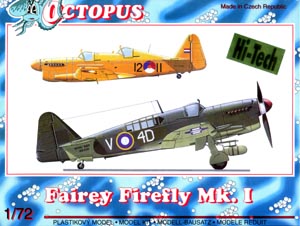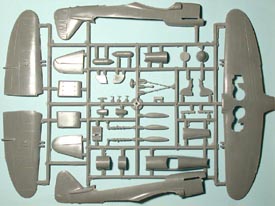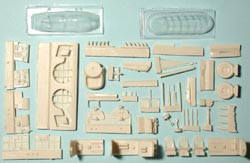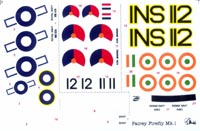Octopus’ 1/72 Fairey
Firefly Mk. I |  | History From early on, the leaders of the Fleet Air Arm were convinced that ship-borne aircraft needed a crew of two due to the complications of navigation over water. It was no surprise, then, when the Admiralty issued a new specification for a fighter/reconnaissance type with two seats in 1939. Fairey designed an all-metal aircraft to this specification, with a Rolls-Royce Griffon engine, four 20mm cannons, and the innovative Fairey-Youngman flap. The FAA expressed great interest in the type and quickly ordered 200 aircraft in June of 1940, with the first Firefly reaching the Royal Navy in March of 1943. One of the first battles of the Firefly was an attack on the battleship Tirpitz in Norwegian waters, but shortly after that, the Fireflies went to the Indian and Pacific Oceans for the duration of the war. By the end of production in the summer of 1946, a total of 658 Firefly Mk. Is were produced.  The Kit The Kit
This box carries a sticker on the front saying “Hi-Tech”, which means resin and lots of it. In fact, there are more resin parts than injection plastic parts in this kit, with 41 resin pieces and 37 plastic pieces. In addition to these, the kit comes with two sets of vacuformed canopies. For markings, there are no less than four options on the decal sheet. All together this is easily the best 1/72 Firefly kit on the market today. A closer look at the resin reveals a detailed interior. The front cockpit is entirely resin, with the floor and rear bulkhead molded as one piece. The sidewalls, instrument panel, seat, and control stick are all separate. As one of the decal options is for a Firefly T.1, Pavla provides two different options for the rear cockpit. The T.1 version mimics the front cockpit, while the regular Mk. I cockpit features a one-piece floor, sidewalls, a shelf and a seat. All together, these parts will create a very nice interior front and back for both versions.  The fuselage is split in the traditional manner of right and left halves, with a separate resin nosepiece. The exhaust stacks are separate and cast in resin as well. Separate fuselage tops are provided for the T.1 and Mk. I options. An insert for the fuselage underside provides the tailhook recess, with the hook itself molded separately. The fuselage is split in the traditional manner of right and left halves, with a separate resin nosepiece. The exhaust stacks are separate and cast in resin as well. Separate fuselage tops are provided for the T.1 and Mk. I options. An insert for the fuselage underside provides the tailhook recess, with the hook itself molded separately.
The wings are molded in three pieces, with the lower piece incorporating part of the fuselage. A nice resin wheel well insert adds a lot of detail in this area. A couple of wing gun options are included, those being open barrels or covered ones. The landing gear is quite detailed, with a combination of plastic and resin parts. Also for under the plane is an optional radar pod. The tail planes are molded as solid right and left pieces, and there are separate mass balances for all the control surfaces.  The decal options include one FR Mk. I, one F. Mk. I, one T.1, and one TT.1. The FR Mk. I and F Mk. I both are camouflaged in dark slate gray and extra dark sea gray over sky. The FR Mk. I is coded 4D-V and was from No. 812 Squadron off of the HMS Vengeance. The F Mk. I was also from No. 812 Squadron and carries the number 286 on the fuselage in white. The T.1 is an overall yellow Firefly of the Netherlands Royal Navy. The TT.1 is probably the most striking of all the options. From the Indian Navy, this plane is overall aluminum dope, with the undersides finished in yellow and black diagonal lines. Coupled with the Indian roundels of green, white and orange, this plane will really stand out. The decals are well printed and in good register and should pose no problem. The decal options include one FR Mk. I, one F. Mk. I, one T.1, and one TT.1. The FR Mk. I and F Mk. I both are camouflaged in dark slate gray and extra dark sea gray over sky. The FR Mk. I is coded 4D-V and was from No. 812 Squadron off of the HMS Vengeance. The F Mk. I was also from No. 812 Squadron and carries the number 286 on the fuselage in white. The T.1 is an overall yellow Firefly of the Netherlands Royal Navy. The TT.1 is probably the most striking of all the options. From the Indian Navy, this plane is overall aluminum dope, with the undersides finished in yellow and black diagonal lines. Coupled with the Indian roundels of green, white and orange, this plane will really stand out. The decals are well printed and in good register and should pose no problem.
Conclusion This is a great kit of the Firefly and a welcome addition to any Fleet Air Arm collection. With the ample resin details included, there is little left in want. The interesting collection of markings will assure that this kit will appeal with just about anyone. Definitely recommended. | 








|
